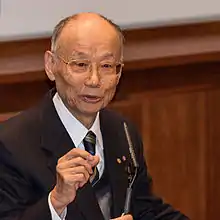Satoshi Ōmura | |
|---|---|
大村 智 | |
 Satoshi Ōmura, Nobel Laureate in medicine in Stockholm December 2015 | |
| Born | 12 July 1935 Nirasaki, Yamanashi, Japan |
| Nationality | Japanese |
| Alma mater | University of Yamanashi (BS) Tokyo University of Science (MS, ScD) University of Tokyo (PhD) |
| Known for | Avermectin and Ivermectin Discovery of more than 480 new compounds |
| Awards | Japan Academy Prize (1990) Koch Gold Medal (1997) Ernest Guenther Award in the Chemistry of Natural Products (2005) Tetrahedron Prize for Creativity in Organic Chemistry (2010) Gairdner Global Health Award (2014) Nobel Prize in Physiology or Medicine (2015) |
| Scientific career | |
| Fields | Biochemistry |
| Institutions | Kitasato University Wesleyan University |
| Academic advisors | Koji Nakanishi Max Tishler |
Satoshi Ōmura (大村 智, Ōmura Satoshi, [oːmɯɾa saꜜtoɕi]; born 12 July 1935) is a Japanese biochemist. He is known for the discovery and development of hundreds of pharmaceuticals originally occurring in microorganisms. In 2015, he was awarded the Nobel Prize in Physiology or Medicine jointly with William C. Campbell for their role in the discovery of avermectins and ivermectin,[1] the world's first endectocide and a safe and highly effective microfilaricide.[2] It is believed that the large molecular size of ivermectin prevents it from crossing the blood/aqueous humour barrier, and renders the drug an important treatment of helminthically-derived blindness.
Early life and education
Satoshi Ōmura was born in Nirasaki, Yamanashi Japan in 1935, the second son of Ōmura family. After graduating from the University of Yamanashi in 1958, he was appointed to science teacher at Tokyo Metropolitan Sumida Tech High School. In 1960, he became an auditor of Koji Nakanishi’s course at Tokyo University of Education, one year later, he enrolled in the Tokyo University of Science (TUS) and studied sciences. Ōmura received his M.S. degree from TUS and his Ph.D. in Pharmaceutical Sciences from the University of Tokyo (1968, a Dissertation PhD) and a Ph.D. in Chemistry at TUS (1970).[3]
Career
Since 1965 Ōmura served at Kitasato Institute system.[4] From 1970 to 1990, he also became a part-time lecturer at Tokyo University of Science.[5]
In 1971 while he was a visiting professor at Wesleyan University,[4] he consulted the chairman of the American Chemical Society, Max Tishler, at an international conference. Together they successfully acquired research expenses from Merck & Co.[6] Ōmura was considering continuing his research in the United States, but ultimately he decided to return to Japan.
In 1973, he became a director of the antibiotic laboratory at Kitasato University,[7] and he also started collaborative research with Merck & Co.[8]
In 1975, he became professor of Kitasato University School of Pharmacy. Meanwhile, the Ōmura laboratory raised many researchers and produced 31 university professors and 120 doctors.
At present date, Ōmura is professor emeritus at Kitasato University and Max Tishler Professor of Chemistry at Wesleyan University.
Research

Satoshi Ōmura is known for the discovery and development of various pharmaceuticals originally occurring in microorganisms. He was awarded the 2015 Nobel Prize in Physiology or Medicine jointly with William C. Campbell and Tu Youyou for discoveries concerning a novel therapy against infections caused by roundworm parasites. More precisely, his research group isolated a strain of Streptomyces avermitilis that produce the anti-parasitical compound avermectin.[2] Campbell later acquired these bacteria and developed the derived drug ivermectin that was first commercialised for veterinary use in 1981 later put to human use against Onchocerciasis in 1987–88 with the name Mectizan,[2] and is today used against river blindness, lymphatic filariasis, scabies and other parasitic infections.[3][9][10]
Since the 1970s, Ōmura has discovered more than 480 new compounds, of which 25 kinds of drugs and reagents are in use. Examples include andrastin, herbimycin, neoxaline as well as:
- a specific inhibitor of protein kinase named staurosporine;
- a proteasome inhibitor named lactacystin;
- a fatty acid biosynthesis inhibitor named cerulenin;
Furthermore, compounds having a unique structure and biological activity discovered by Omura are drawing attention in drug discovery research, and new anticancer drugs and the like have been created.
Selected publications
- Satoshi Ōmura; Y Iwai; A Hirano; A Nakagawa; J Awaya; H Tsuchya; Y Takahashi; R Masuma (April 1977). "A new alkaloid AM-2282 OF Streptomyces origin. Taxonomy, fermentation, isolation and preliminary characterization". The Journal of Antibiotics. 30 (4): 275–82. doi:10.7164/ANTIBIOTICS.30.275. ISSN 0021-8820. PMID 863788. Wikidata Q28279608.
- R. W. Burg; B. M. Miller; E. E. Baker; et al. (March 1979). "Avermectins, new family of potent anthelmintic agents: producing organism and fermentation". Antimicrobial Agents and Chemotherapy. 15 (3): 361–7. doi:10.1128/AAC.15.3.361. ISSN 0066-4804. PMC 352666. PMID 464561. Wikidata Q24598202.
- D A Hopwood; F Malpartida; H M Kieser; et al. (1 April 1985). "Production of 'hybrid' antibiotics by genetic engineering". Nature. 314 (6012): 642–644. doi:10.1038/314642A0. ISSN 1476-4687. PMID 3857464. Wikidata Q59071761.
- H Ikeda; T Nonomiya; M Usami; T Ohta; Satoshi Ōmura (1 August 1999). "Organization of the biosynthetic gene cluster for the polyketide anthelmintic macrolide avermectin in Streptomyces avermitilis". Proceedings of the National Academy of Sciences of the United States of America. 96 (17): 9509–9514. Bibcode:1999PNAS...96.9509I. doi:10.1073/PNAS.96.17.9509. ISSN 0027-8424. PMC 22239. PMID 10449723. Wikidata Q33871234.
- Masahiko Hayashi; Mun-Chual Rho; Akiko Enomoto; et al. (4 November 2002). "Suppression of bone resorption by madindoline A, a novel nonpeptide antagonist to gp130". Proceedings of the National Academy of Sciences of the United States of America. 99 (23): 14728–14733. Bibcode:2002PNAS...9914728H. doi:10.1073/PNAS.232562799. ISSN 0027-8424. PMC 137487. PMID 12417753. Wikidata Q34379185.
- Tomoyasu Hirose; Toshiaki Sunazuka; Satoshi Omura (1 January 2010). "Recent development of two chitinase inhibitors, Argifin and Argadin, produced by soil microorganisms". Proceedings of the Japan Academy, Series B. 86 (2): 85–102. doi:10.2183/PJAB.86.85. ISSN 0386-2208. PMC 3417560. PMID 20154467. Wikidata Q34098670.
- Nobuyuki Matoba; Adam S Husk; Brian W Barnett; et al. (2010). "HIV-1 neutralization profile and plant-based recombinant expression of actinohivin, an Env glycan-specific lectin devoid of T-cell mitogenic activity". PLOS One. 5 (6): e11143. Bibcode:2010PLoSO...511143M. doi:10.1371/JOURNAL.PONE.0011143. ISSN 1932-6203. PMC 2886112. PMID 20559567. Wikidata Q21076115.
- Hirofumi Nakano; Satoshi Omura (9 January 2009). "Chemical biology of natural indolocarbazole products: 30 years since the discovery of staurosporine". The Journal of Antibiotics. 62 (1): 17–26. doi:10.1038/JA.2008.4. ISSN 0021-8820. PMID 19132059. Wikidata Q34918248.
- Ōmura, S. (2011). "Microbial metabolites: 45 years of wandering, wondering and discovering". Tetrahedron. 67 (35): 6420–6459. doi:10.1016/j.tet.2011.03.117.
Social role
Ōmura served as deputy director and director at the Kitasato Institute. He was devoted to rebuild the laboratory and promoting the establishment of the medical center that is now Kitasato University Medical Center. Meanwhile, he established a path to rebuilding of the corporate school juridical person, which has integrated with the School corporation Kitasato Gakuen. He succeeded in establishing a new "School corporation Kitasato Institute". In addition, he served as president of the School corporation Joshibi University of Art and Design twice, and served as the honorary school chief of the School corporation Kaichi Gakuen.[11] In 2007, he established the Nirasaki Omura Art Museum on his collection.[12]
Awards and honors

A Children's statues leading to adults of onchocerciasis before Kitasato University buildings were produced by sculptors of Burkina Faso in honor of Ōmura's contributions of avermectin and ivermectin, a symbol of the campaign to eradicate onchocerciasis.[13] Similar life-sized bronze statues were erected in World Health Organization (WHO) Headquarters, Carter Center, Merck & Co., World Bank Headquarters, and Burkina Faso's World Health Organization Africa Onchocerciasis Control Program.
- 1985 – Hoechst-Roussel Award[14]
- 1986 – The Pharmaceutical Society of Japan Award[14]
- 1988 – Uehara Prize[14]
- 1990 – Japan Academy Prize (academics)[14]
- 1992 – Medal with Purple Ribbon[14]
- 1995 – Fujihara Award[14]
- 1997 – Robert Koch Gold Medal[15]
- 1998 – Prince Mahidol Award[14]
- 2000 – Nakanishi Prize (American Chemical Society and Chemical Society of Japan)[14]
- 2005 – Ernest Guenther Award in the Chemistry of Natural Products (American Chemical Society)[14]
- 2007 – Hamao Umezawa Memorial Award[14]
- 2008 – Knight of the Legion of Honour of France
- 2010 – Tetrahedron Prize for Creativity in Organic Chemistry[14]
- 2011 – Arima Award[14]
- 2011 – Order of the Sacred Treasure, Gold and Silver Star[16]
- 2012 – Person of Cultural Merit[14]
- 2014 – Canada Gairdner Global Health Award[17]
- 2015 – Asahi Prize[14]
- 2015 – The Order of Cultural Merit[14]
- 2015 – Nobel Prize in Physiology or Medicine
Honorary doctorates
List of honorary doctorates:[18]
- 1992 – Lajos Kossuth University, Hungary
- 1994 – Wesleyan University, USA
- 2016 – Shanghai Jiao Tong University, China
- 2018 – University of St Andrews, Scotland
Learned societies membership
- 1992 – Academy of Sciences Leopoldina[19]
- 1999 – National Academy of Sciences[20]
- 2001 – Japan Academy[21]
- 2002 – Académie des sciences[22]
- 2005 – Russian Academy of Sciences
- 2005 – Royal Society of Chemistry
- 2005 – Academia Europaea
- 2006 – Chinese Academy of Engineering
- 2009 – Japan Society for Bioscience, Biotechnology and Agrochemistry
- 2014 – Pharmaceutical Society of Japan
- 2016 – Japan Pharmaceutical Association
- 2016 – Japan Society of Synthetic Organic Chemistry
- 2016 – Japan Society of Chemotherapy
See also
References
- ↑ "The Nobel Prize in Physiology or Medicine 2015". Nobel Prize Outreach AB. 6 October 2015.
- 1 2 3 Andy Crump; Satoshi Ōmura (1 January 2011). "Ivermectin, 'wonder drug' from Japan: the human use perspective". Proceedings of the Japan Academy, Series B. 87 (2): 13–28. Bibcode:2011PJAB...87...13C. doi:10.2183/PJAB.87.13. ISSN 0386-2208. PMC 3043740. PMID 21321478. Wikidata Q34598257.
- 1 2 "Satoshi Omura PhD". Retrieved 5 October 2015.
- 1 2 大村智北里研究所顧問・北里大学名誉教授が文化功労者に 北里大学 2012年11月1日
- ↑ [from ストックホルム]「これからは人材の育成に努力します」大村先生が語った受賞後の活動 TUSToday 2015.12.18
- ↑ 「人間発見」日本経済新聞2010年7月14日
- ↑ 「【ノーベル賞受賞】大村智氏、常識破りの発想で治療薬開発 」 産経ニュース2015.10.5
- ↑ 「 新しい微生物創薬の世界を切り開く 」 JT
- ↑ Press release NobelPrize.org
- ↑ "Japanese microbiologist Satoshi Omura shares Nobel Prize for medicine". The Japan Times. 5 October 2015. Retrieved 5 October 2015.
- ↑ "大村先生". 開智学園高等部. Retrieved 2015-10-12.
- ↑ "韮崎大村美術館 館長あいさつ 大村智". 韮崎大村美術館. Archived from the original on 2015-10-15. Retrieved 2015-10-12.
- ↑ "『新しい微生物創薬の世界を切り開く』大村 智". サイエンティスト・ライブラリー | JT生命誌研究館. Retrieved 14 March 2022.
- 1 2 3 4 5 6 7 8 9 10 11 12 13 14 15 Satoshi Ōmura. "Satoshi Ōmura Curriculum Vitae" (PDF).
- ↑ "Robert Koch Gold Medal". Robert-Koch-Stiftung e.V. Retrieved 2015-10-05.
- ↑ 【政府】11年「春の叙勲」‐森田氏に旭重、大村氏が瑞重 薬事日報 2011年6月20日
- ↑ "Satoshi Ōmura". Retrieved 14 March 2022.
- ↑ http://www.satoshi-omura.info/biography/omura_cv.pdf
- ↑ "List of Members | Prof. Dr. Dr. Satoshi Ōmura". Retrieved 14 March 2022.
- ↑ "Satoshi Omura". www.nasonline.org. Retrieved 14 March 2022.
- ↑ "Personal Information – ŌMURA Satoshi | The Japan Academy". www.japan-acad.go.jp. Retrieved 14 March 2022.
- ↑ "Satoshi Omura | Liste des membres de l'Académie des sciences / O | Listes par ordre alphabétique | Listes des membres | Membres | Nous connaître". www.academie-sciences.fr. Retrieved 14 March 2022.
